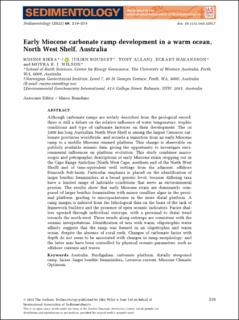Early Miocene carbonate ramp development in a warm ocean, North West Shelf, Australia
Peer reviewed, Journal article
Published version
Permanent lenke
https://hdl.handle.net/11250/3023532Utgivelsesdato
2021Metadata
Vis full innførselSamlinger
- NGI articles [1061]
Sammendrag
Although carbonate ramps are widely described from the geological record,there is still a debate on the relative influence of water temperature, trophicconditions and type of carbonate factories on their development. Theca2400 km long Australian North West Shelf is among the largest Cenozoic car-bonate provinces worldwide, and records a transition from an early Mioceneramp to a middle Miocene rimmed platform. This change is observable onpublicly available seismic data, giving the opportunity to investigate envi-ronmental influences on platform evolution. This study combines macro-scopic and petrographic descriptions of early Miocene strata cropping out inthe Cape Range Anticline (North West Cape, southern end of the North WestShelf) and of time-equivalent well cuttings from the adjacent, offshoreExmouth Sub-basin. Particular emphasis is placed on the identification oflarger benthic foraminifera at a broad generic level, because differing taxahave a limited range of habitable conditions that serve as environmentalproxies. The results show that early Miocene strata are dominantly com-posed of larger benthic foraminifera with minor coralline algae in the proxi-mal platform, grading to micropackstones in the more distal platform. Aramp margin is inferred from the lithological data on the basis of the lack offramework builders and the presence of open oceanic indicators. Facies shal-low upward through individual outcrops, with a proximal to distal trendtowards the north-west. These trends along outcrops are consistent with theseismic interpretations. Identification of taxa with warm, oligotrophic wateraffinity suggests that the ramp was formed in an oligotrophic and warmocean, despite the absence of coral reefs. Changes of carbonate facies withdepth do not seem to be associated with changes in ramp morphology, andthe latter may have been controlled by physical oceanic parameters, such asoffshore currents and waves. Early Miocene carbonate ramp development in a warm ocean, North West Shelf, Australia
